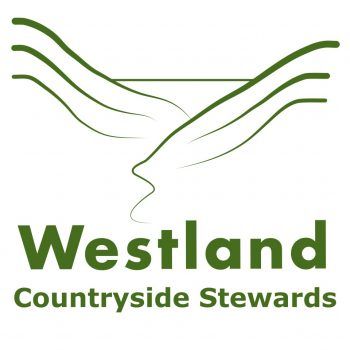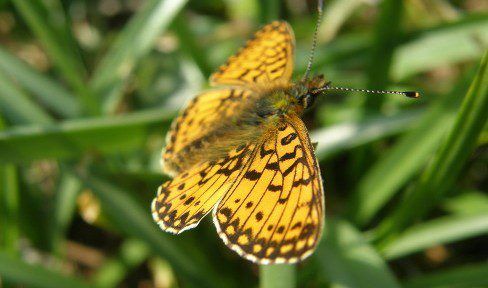Looking back over the last few months, work on Kilkhampton Common may not be completely visible, but behind the scenes a lot has taken place from surveys to new signage. The excellent weather conditions this year have been beneficial for all flora and fauna. The results can be clearly seen with the rise of butterfly numbers not just at Kilkhampton, but through the whole of the UK. In 2014 a total of 1,100,189 butterflies were recorded within the UK, which is an increase of 82,379 butterflies from the previous year.
Kilkhampton Common had 21 species of butterflies recorded this year, from the common Gatekeeper (Pyronia tithonus) to the rarer Small Pearl-bordered Fritillary (Boloria selene) (pictured). This year on the Common, 1,275 butterflies were recorded, with an extraordinary 206 on just one survey! With new management plans in place these figures should increase. A rotational vegetation cut has been planned to ensure the butterflies have shelter and a food source when it is most needed and to encourage new growth.
With a little more work the Common could be home to a wider range of butterfly species, including the rare Pearl-bordered Fritillary (Bolaria euphrosyne), which resides in Marsland reserve just to the north of Kilkhampton. The Pearl-bordered Fritillary has been in major decline and the Common would be a perfect habitat.
Lots of other species have also been spotted on the Common. Moths such as the Silver Y (Autogrpha gamma) (pictured) and the Speckled Yellow (Pseudopanthera macularia) have been seen soaking up the sun. Drinker Moth (Euthrix potatoria) and Qak Eggar moth (Lasiocampa quercus) caterpillars have been moved off the paths to prevent people standing on them! Damselflies and dragonflies have also been in abundance over the summer months. The Large Red Damselfly (Pyrrhosoma nymphula) and the Golden Ringed dragonfly (Cordulegaster boltonii) have been using the ponds on the Common as breeding and ovipositing habitat. Adders have also been spotted along the paths in the sun.
As well as species making a natural recovery, we have released a species which have been in a decline. The Harvest Mouse (Micromys minutes) has been in decline due to the increase of arable farming, and livestock grazing. As the Common is a “hub” for a large number of species, a release was carried out in July, although they may not be easily seen as they are the smallest mouse in Europe! Harvest mice are beneficial to the land as they provide other animals, such as birds of prey and snakes with a valuable food source.
A flora survey was also carried out on the Common, and many species such as Bugle (Ajuga reptans), Devils-bit Scabious (Succisa pratensis), both of which are important for butterflies, Wild Strawberry (Fragaria vesca) and the rarer Yellow-flowered Strawberry (Potentilla indica) (pictured) could be found in the different habitats.
Kilkhampton Common has recently been funded by the National Lottery to erect signage. “Kilkhampton Common” signs can be seen at the two main entrances, to encourage people onto the land as well as to provide information as to site name and ownership. Two new lecterns have also been erected, which are situated on the Common itself (both pictured). The lecterns provide a small amount of information regarding the Westland Countryside Stewards charity along with some species-specific information for those who are interested. Each lectern displays a map informing not only where the person is, but also showing where some of the species can be seen. All of the signs are made from recycled plastic, making them both eco-friendly and durable. The Commons have recently been published in the IWalk North Cornwall guide with the aim to get more people on the area.
Ash dieback (Chalara fraxinea) is a fungus-based disease that causes leaf loss, crown dieback and lesions on the bark of affected trees, leading to the inevitable death of the tree. The ash (Fraxinus excelsior) trees on the Common have been monitored for the disease, using AshTag. Selected trees are tagged with a number and each tree is monitored for the disease and the results, positive or negative, are then put on to the website to show where the disease can be found and where it has not yet spread.

